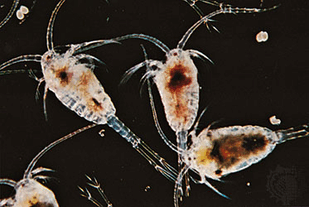
Hungry Crustaceans Eat Climate Change Experiment 291
Earlier this month, an expedition fertilized 300 square kilometers of the Atlantic Ocean with six metric tons of dissolved iron. This triggered a bloom of phytoplankton, which doubled their biomass within two weeks by taking in carbon dioxide from the seawater. The dead phytoplankton were then expected to sink to the ocean bed, dragging carbon along with them. Instead, the experiment turned into an example of how the food chain works, as the bloom was eaten by a swarm of hungry copepods. The huge swarm of copepods were in turn eaten by larger crustaceans called amphipods, which are often eaten by squid and whales. "I think we are seeing the last gasps of ocean iron fertilization as a carbon storage strategy," says Ken Caldeira of the Carnegie Institution at Stanford University. While the experiment failed to show ocean fertilization as a viable carbon storage strategy, it has pushed the old "My dog ate my homework" excuse to an unprecedented level.

So? (Score:4, Funny)
Why are well-fed whales a bad thing?
Obligatory Simpsons Joke (Score:5, Funny)
Skinner: Well, I was wrong. The lizards are a godsend.
Lisa: But isn't that a bit short-sighted? What happens when we're overrun by lizards?
Skinner: No problem. We simply unleash wave after wave of Chinese needle snakes. They'll wipe out the lizards.
Lisa: But aren't the snakes even worse?
Skinner: Yes, but we're prepared for that. We've lined up a fabulous type of gorilla that thrives on snake meat.
Lisa: But then we're stuck with gorillas!
Skinner: No, that's the beautiful part. When wintertime rolls around, the gorillas simply freeze to death.
I'll be (Score:3, Funny)
Whale i'll be damned!
Horray! (Score:5, Funny)
Horray for Zoidberg!
Re:So... (Score:3, Funny)
It's been converted into whale farts.
Re:Why is this a problem? (Score:1, Funny)
We could catch the whales, render their blubber into oil and store it underground or something... um, I guess it would be easier not to burn oil in the first place.
Comment removed (Score:2, Funny)
Re:Why Can't This Work... (Score:4, Funny)
Can't we fertilize parts of the ocean for plant growth instead?
Maybe a few well placed depth charges filled with Miracle-Gro
Re:Well it sounds better than (Score:1, Funny)
Why do you want to shoot Hanz and Franz?
Re:Not for carbon sequestration, but how about foo (Score:3, Funny)
Perhaps. I suspect it'll just make a new sub-species of fat, lazy whales.
$#@&*!$ lazy-ass whales.
Re:So... (Score:3, Funny)
Best argument against "Save the whales" I heard to date.
Who knew Captain Ahab was trying to save the planet all along?
Re:Well it sounds better than (Score:3, Funny)
Altering the method might fix it.
Simple! Spike the iron with a good pesticide. Problem solved!
(Yes, this was intended to be a joke.)
Re:Not for carbon sequestration, but how about foo (Score:5, Funny)
Perhaps. I suspect it'll just make a new sub-species of fat, lazy whales.
Americans? *rimshot*
Round of applause (Score:4, Funny)
I can't believe it! A slashdot headline that mentioned global warming, but does not include a global warming debate in the comments. How do I submit this as a story?
Re:Obligatory Simpsons Joke (Score:4, Funny)
"Look, I can explain," he said.
Lord Vetinari lifted an eyebrow with the care of one who, having found a piece of caterpillar in his salad, raises the rest of the lettuce.
"Pray do," he said, leaning back.
"We got a bit carried away," said Moist. "We were a bit too creative in our thinking. We encouraged mongooses to breed in the posting boxes to keep down the snakes . . ."
Lord Vetinari said nothing.
"Er . . . which, admittedly, we introduced into the letter boxes to reduce the numbers of toads . . ."
Lord Vetinari repeated himself.
"Er . . . which, it's true, staff put in the posting boxes to keep down the snails . . . "
Lord Vetinari remained unvocal.
"Er . . . These, I must in fairness point out, got into the boxes of their own accord, in order to eat the glue on the stamps," said Moist, aware that he was beginning to burble.
Re:Why Can't This Work... (Score:4, Funny)
Sorry about that. I'm a stoner and like to watch SpongeBob
Fixed that for you. We all know you couldn't have a kid -- that would require sex and you are posting on /.
Re:Well it sounds better than (Score:4, Funny)
The zebra mussels (which hitched a ride with ship ballast from Europe)
Ah, the famous mussles from Brussels.
Re:This experiment was NOT a failure! (Score:4, Funny)
I.E slowly release Fe off the back of shipping vessels for 100's of miles
I think this could be done fairly simply by encouraging more tramp steamers to fly under Liberian registry. Those hulls simply drip Fe2O3nH2O and must be very good for phytoplankton growth.
Re:Well it sounds better than (Score:2, Funny)